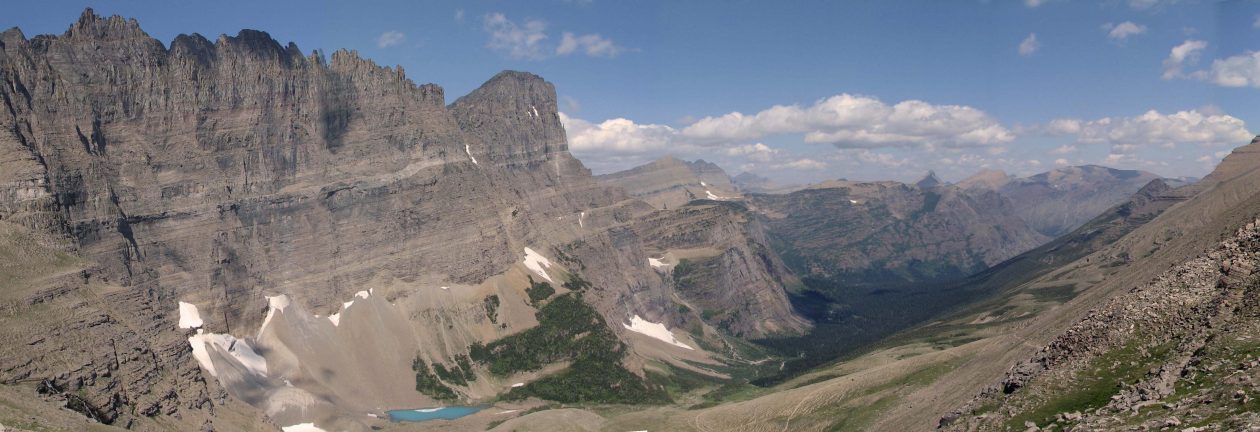Xi’an, China
I was awoken on my hard bunk in one of the sleeper cars on the train hurdling toward Xi’an at about 04:20. The attendants were already tearing down the curtains and tidying up their respective cars before we reached our destination; though we were soon there in about another twenty minutes. I was coughing incessantly when I woke up due to having inadvertently smoked a pack of cigarettes during my sleep, since all the tobacco smoke from in between the cars had drifted to my nearby bunk. I grabbed my bags and headed out of train station. I then went in to the actual entrance of the Xi’an Train Station to buy my onward ticket to Nanjing. I then walked down Jiefang Lu Street, it being the only identifiable street on the small map of my Bookings.com printout – I should really research each new destination thoroughly before getting there . . . maybe next time. As I walked through the streets of Xi’an in the early morning, I saw a number of early birds (all elderly men) doing their tried-and-true workout routines that they’ve probably done every morning throughout their lives; one man, in pajamas was boxing a pad tied to a sidewalk tree trunk, another was gracefully moving through Tai Chi exercises, and another was jogging back and forth in a park square. Through blind luck, I actually found the guesthouse I was staying at despite the fact I never saw any of the other streets on my printout’s map. I went in, ordered a beer, signed up for a tour to see the Terracotta Warriors today, had another beer, updated journals, had an expresso, put my things in to the room once it was cleared, and then it was time for the tour.
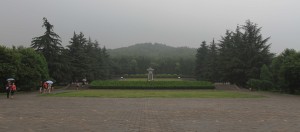
The tour began at 09:20; we loaded up into our buses and in about an hour we were at our first destination: the Emperor Qin Shihuang’s Mausoleum Site Park. In the center of the park is the man-made earthen mound which houses the late Emperor’s remains, and those of his 3,000 concubines (with that many concubines, he should’ve lived longer than Hugh Hefner, but his fatal flaw was drinking mercury – to live longer). The mound has yet to be breached due to the archaeologists’ forbearance in wanting the right technology available and readily in place for when they do enter the mound in order to preserve all the artifacts enclosed inside the tomb. So we just walked up to a monument inside the park and took photos of the nearby mound.
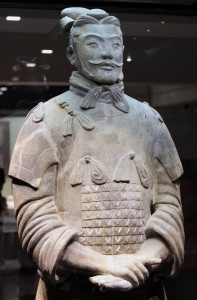
We then walked to the famous pit sites near the park which house the terracotta remains of thousands of warriors (generals, officers, infantrymen, cavalrymen, charioteers, and archers). The whole area was more developed and commercialized than I had imagined from reading National Geographic. There were stalls and vendors lining the whole way to the pits selling touristic garbage; there were even men inside the pit areas trying to sell their miniature models of the terracotta warriors – unbelievable.
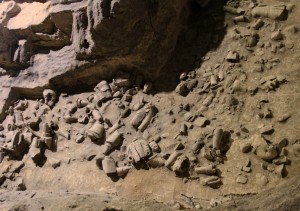
Our first stop was Pit 2, the second pit discovered (in 1976), which has many fractured pieces and many collapsed wooden beams still untouched in the pit that had collapsed over time and now resembled a wavy sea. There were some complete warriors enclosed in glass cases, including an archer that had been found entirely intact – the only terracotta warrior out of all the pits discovered that didn’t need to be glued to completion.

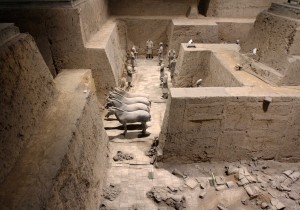
We then headed to Pit 3, the third pit discovered (in 1976), which is the smallest of the three pits and was the Command Headquarters of Pit 1 and 2. This pit also had a chariot with four horses at it’s reins. Furthermore, many of the warriors are missing their heads in this pit – never completed before the Emperor’s untimely death and therefore work ceased in the area before the individual heads were built for a number of the bodies.
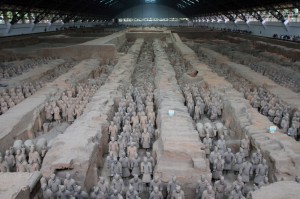
Next we headed to Pit 1, the first pit discovered (in 1974), the most photographed pit, and where the most terracotta warriors were unearthed (they believe that there may be over 6,000 infantrymen in Pit 1, many still to be discovered). The archaeologists still work all three pits during the evening and night; in Pit 1 they are still gathering the pieces and gluing them together, before putting the completed pieces on display with the rest in Pit 1 (you can see a number of the warriors toward the back of the enclosed pit with plastic holding the pieces tight as the glue dries). We then watched a “360-degree” film about the creation of the terracotta warriors during the Emperor’s reign; although one projector was blurry and another was out all together. The film looked like it was produced in 1970s Hollywood (the era of Radley Metzger . . .), which means it was probably produced in the 1990s here. After the film, we then when to the gift shop where the farmer who discovered the warriors back in 1974 sits to sign autographs (somewhat of a national celebrity now). We then left the pits to eat lunch (there were many tasty dishes shared on the revolving platform in the center of the table).
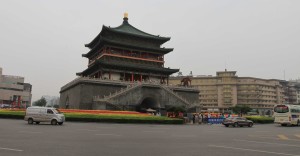
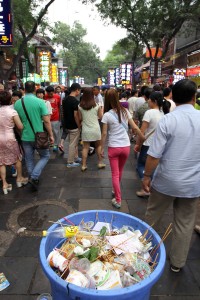
We then headed back to the guesthouse – during the drive back I received excellent travel tips from an Aussie and her traveling companion; she has been all over southeast Asia and told me which budget airlines to book tickets with. Once at the guesthouse, I had another beer before heading out to see the Bell Tower, Drum Tower, South Gate, and ShuYuanMen Ancient Street in Xi’an. After taking in the sites which would’ve have been prominent in the ancient city’s past, I found a restaurant where English was a foreign language. I ordered beer and a compressed soggy fried chicken dish that had a broth underneath it with mushroom slices, ginger, pepper, and bark. It looked like brains when it first came out, but once I bit into the meat it was undeniably chicken. I ate my meal and drank the tea offered on the table before paying my bill, trying to tip the waiter, and having my tip denied. I must remember that only in America are tips expected (even for no service at all).
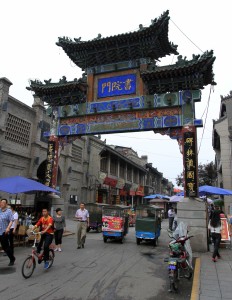
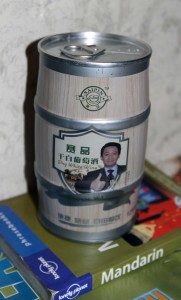
I then bought supplies in a local convenience store, as well as a can of Dry White Wine. It was made in China, but it reminded me of boxed white wine in America, which means it was low-grade, however, I begrudgingly admit, it was drinkable (it was wine in a can with a pull-tab, what else should I expect!). I then went back to the hostel, typed today’s journal entry, and went to sleep.
